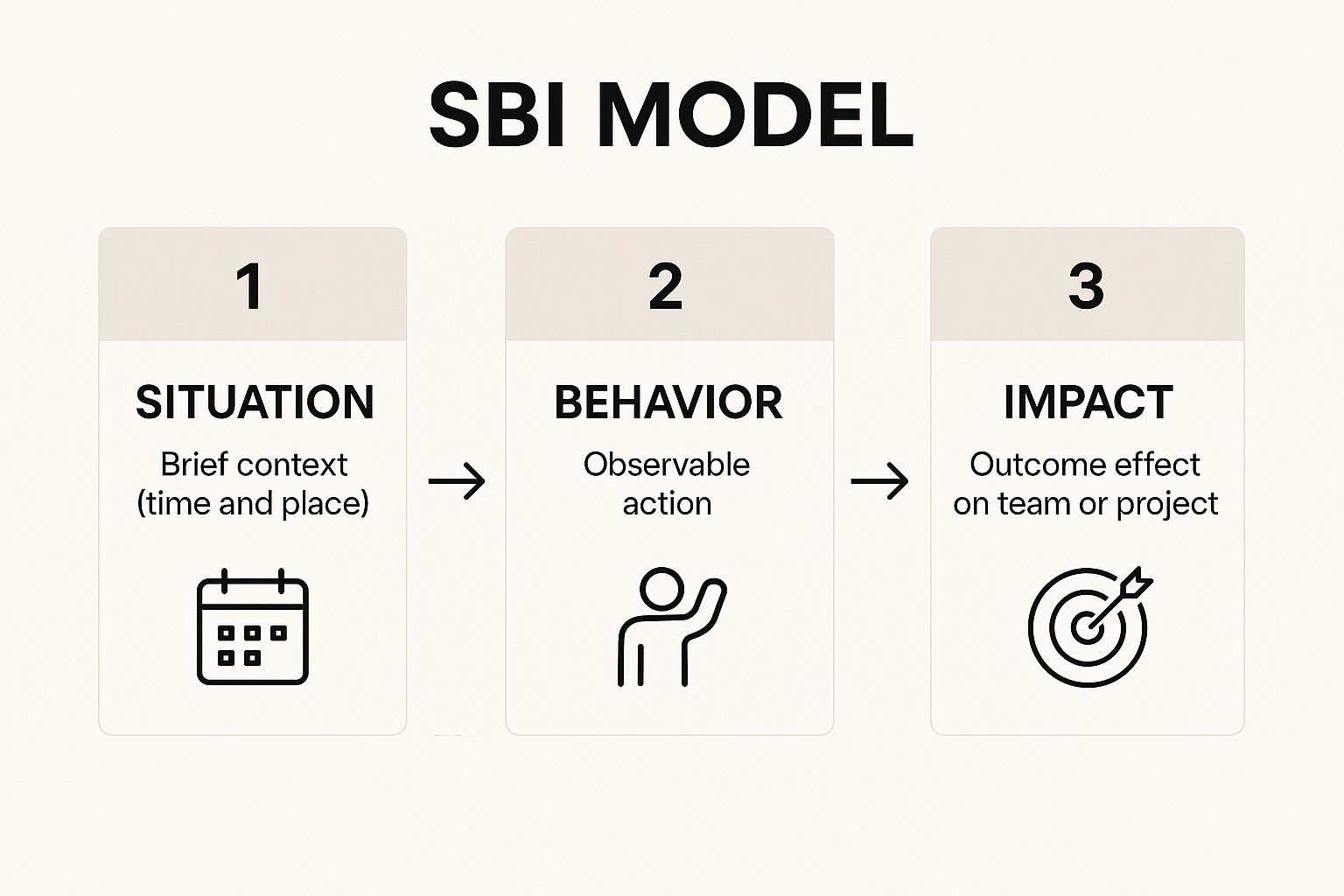In any business, but especially in the trades where teams are often dispersed, the quality of communication directly impacts the bottom line. Misunderstood instructions, delayed updates, and inaccurate job logs don’t just cause frustration; they lead to costly rework, project delays, and unhappy clients. The ability to convey information clearly and efficiently isn't a soft skill, it’s a core operational competency. Mastering how to improve communication at work is the most direct path to boosting productivity, reducing errors, and building a more resilient, coordinated team.
This guide moves beyond generic advice. We will explore specific, actionable frameworks and strategies that you can implement immediately. From structured feedback models like SBI to strategic approaches for crucial conversations, each point is designed to provide you with a practical toolset. You'll learn how to transform team interactions, whether you're a technician in the field updating a job via WhatsApp or an administrator logging details with an AI-powered tool like Nora. For those looking for more region-specific insights, you can find additional practical tips for improving workplace communication that consider local business environments. Let’s dive into the proven methods that will sharpen your team’s communication and drive tangible results.
1. Master the Art of Active Listening
True communication begins not with speaking, but with listening. Active listening is a foundational technique that involves fully concentrating on, understanding, responding to, and then remembering what is being said. It's the difference between hearing words and comprehending the complete message, including the non-verbal cues and emotional undertones that often carry the real meaning.
In a busy workplace, mastering this skill can single-handedly reduce misunderstandings and build profound trust. For technicians in the field, it means correctly diagnosing a client's issue the first time. For administrative staff, it ensures work orders are dispatched with perfect accuracy. This commitment to listening is a direct way to improve communication at work, fostering a culture where every team member feels heard and valued.
How to Practice Active Listening
Instead of planning your reply while someone is talking, focus entirely on their words.
- Paraphrase and Clarify: Repeat back what you heard in your own words. For instance, say, “So, just to confirm, the rattling noise from the HVAC unit only happens in the morning, and you need us to arrive before 10 AM?”
- Ask Open-Ended Questions: Encourage more detail by asking questions that can't be answered with a simple "yes" or "no." Try, “Can you describe what was happening right before the equipment failed?”
- Acknowledge and Validate: Show you understand the speaker’s feelings or situation. A simple, “That sounds frustrating, let’s figure out how to get it fixed quickly,” can build instant rapport.
Pro Tip: When a client sends a detailed service request via a WhatsApp message, don't just reply with "Got it." Instead, summarize their key points back to them to confirm your understanding before dispatching a technician. This simple step prevents costly return visits and ensures customer satisfaction.
2. Adopt the SBI Model for Clearer Feedback
Giving and receiving feedback can be one of the most challenging aspects of workplace communication. The SBI (Situation-Behavior-Impact) model, developed by the Center for Creative Leadership, provides a simple yet powerful framework to deliver feedback that is clear, specific, and professional. It strips away personal judgments and focuses on objective facts, making difficult conversations more productive.
For a field service team, using SBI can turn a vague complaint into a teachable moment. Instead of a manager saying, “You need to be better with customers,” they can provide precise, actionable feedback. This structured approach helps improve communication at work by transforming criticism into a constructive dialogue focused on growth, which is why major organizations like Google and IBM integrate it into their management training.
How to Use the SBI Model
Structure your feedback around these three distinct parts to ensure clarity and reduce defensiveness.
- Situation: Start by setting the scene. Be specific about the "when" and "where" the event occurred. For example, "Yesterday afternoon, when you were at the Johnson residence for the plumbing repair..."
- Behavior: Describe the specific, observable actions, not your interpretation or assumptions about them. Say, “...you left the old piping on their lawn instead of hauling it away as per our company policy.” This is factual and avoids accusatory language.
- Impact: Explain the consequence of the behavior. This could be the effect on a client, the team, or the business. For instance, “...the impact was that the client called us to complain, which affects our reputation for professionalism and required me to send another technician out to clean up.”
This infographic breaks down the SBI model into its three core components, showing how to move from a general situation to a specific impact. Following this logical flow ensures your feedback is structured, objective, and focused on a resolution rather than blame.
Following this logical flow ensures your feedback is structured, objective, and focused on a resolution rather than blame.
Pro Tip: When a project runs behind schedule, use SBI to address the issue with your team. Instead of saying, “We’re falling behind,” try this: "On the downtown office installation (Situation), I noticed daily progress reports are being submitted at the end of the day instead of by noon (Behavior). This means we can't order parts in time, delaying the next day's work (Impact)." This clarifies the exact problem and its direct consequence.
3. Nonviolent Communication (NVC)
Conflict and misunderstandings often arise from how we express ourselves, especially under pressure. Nonviolent Communication (NVC), a framework developed by psychologist Marshall Rosenberg, offers a powerful way to navigate difficult conversations by focusing on empathy and honest expression. It guides us to state our needs and feelings clearly without resorting to blame, criticism, or demands that put others on the defensive.

In a technical services business, this approach can transform tense client interactions or internal team disagreements. A technician can use NVC to address a delayed parts delivery with an administrator, or an office manager can use it to resolve a scheduling conflict between two team members. Adopting this method helps improve communication at work by creating a safer, more collaborative environment where problems are solved together instead of assigned as blame.
How to Practice Nonviolent Communication
The NVC process is built on four core components: Observations, Feelings, Needs, and Requests.
- State a clear Observation: Describe what you see or hear without judgment. For example, "When I see that the work order notes haven't been updated by the end of the day..."
- Express your Feeling: Use "I" statements to own your emotions. Continue with, "...I feel concerned..."
- Identify your Need: Explain the underlying need that is causing your feeling. "...because I need to have accurate information to handle client billing and follow-up calls correctly."
- Make a specific Request: Ask for a concrete action that would meet your need. "Would you be willing to complete your notes in the system right after finishing each job?"
Pro Tip: When a client is upset about a recurring issue, start by observing their situation without judgment: "I see this is the third time we've been called out for the same leak." Then, empathize with their feelings before moving to a solution. This de-escalates tension and shows you're focused on resolving their need, not just closing a ticket.
4. Embrace Radical Candor
Effective feedback is the lifeblood of a high-performing team, yet it’s often avoided. Radical Candor, a management philosophy developed by Kim Scott, offers a powerful framework that combines caring personally with challenging directly. It’s about being honest and direct, but doing so from a place of genuine respect and a desire to help your colleagues succeed.
For a field service business, this means a manager can directly address a technician’s recurring lateness without causing resentment, or a team member can point out an invoicing error to an administrator constructively. This approach helps to improve communication at work by creating a culture where feedback is seen not as criticism, but as a tool for collective growth. It builds psychological safety, allowing for open dialogue that solves problems faster.
How to Practice Radical Candor
The key is to prove you care before you critique. Start by building a foundation of trust.
- Show You Care, Then Challenge: Frame your feedback with genuine concern. Instead of saying, “Your reports are always late,” try, “I want to see you succeed on this project, but I’ve noticed your last few reports have been late. Is there anything blocking you that I can help with?”
- Be Specific and Sincere: Vague feedback is unhelpful. Pinpoint the exact behavior and its impact. For example, “When you left the work site messy, it reflected poorly on our company and we received a client complaint. We need to ensure we always clean up thoroughly.”
- Encourage Feedback on Yourself: Ask your team for candid feedback on your own performance and communication style. This makes feedback a two-way street and demonstrates that you are also committed to improvement.
Pro Tip: When a technician makes a mistake on a job, don't wait for a formal review. Use a secure platform like WhatsApp to send a private, direct message. Start with praise for their hard work, then clearly and kindly explain the mistake and how to avoid it next time. This immediate, private feedback is far more effective than public criticism or delayed reviews.
5. Adapt Your Style with the DISC Communication Model
Understanding that not everyone communicates the same way is a massive leap forward. The DISC model is a powerful behavioral tool that helps you do just that by categorizing communication styles into four types: Dominance (D), Influence (I), Steadiness (S), and Conscientiousness (C). Recognizing these patterns in colleagues and clients allows you to adapt your approach for maximum clarity and impact.
Using this framework helps you improve communication at work by moving beyond a one-size-fits-all mentality. For a field technician, this means knowing how to deliver a diagnosis to a direct, results-focused (D) client versus a detail-oriented, analytical (C) client. This tailored communication builds trust and prevents the friction that arises from mismatched styles, leading to smoother service calls and more effective teamwork.
How to Use the DISC Model
Start by learning your own dominant style, then practice identifying others' preferences.
- Learn to Identify Styles: Observe your colleagues. Is your dispatcher fast-paced and decisive (D)? Is a senior technician outgoing and persuasive (I)? Is the office manager calm and supportive (S)? Or is the parts specialist precise and data-driven (C)?
- Adapt Your Approach: When speaking to a "D" type, be direct and focus on results. For an "I" type, be friendly and enthusiastic. With an "S" type, be patient and supportive. For a "C" type, provide accurate data and details.
- Focus on Behavior, Not Identity: Remember that DISC describes observable behaviors, not a person's entire personality or value. Use it as a tool for understanding, not for labeling people.
Pro Tip: Before a service call, quickly assess the client's communication style from their initial WhatsApp message or phone call. A short, "Fix my AC now" message suggests a 'D' style, while a long, detailed description of the problem points to a 'C' style. Adjusting your technician's pre-arrival and on-site communication accordingly can turn a good service call into a great one.
6. Employ the Crucial Conversations Framework
Not all conversations are created equal. Some are high-stakes discussions where opinions vary and emotions run strong. The Crucial Conversations framework, developed by Patterson, Grenny, McMillan, and Switzler, provides a methodology for navigating these tense moments productively, turning potential conflicts into constructive dialogues. It’s about creating psychological safety so everyone can speak their mind freely.
This approach is vital for any team aiming to improve communication at work, especially when dealing with sensitive topics like performance issues, project disagreements, or client complaints. For technicians, it could mean discussing a persistent equipment problem with a frustrated property manager. For administrative staff, it might involve resolving a billing dispute with a major client. Using this framework prevents issues from festering and builds a resilient, solution-focused team culture.
How to Apply the Crucial Conversations Framework
Focus on mutual purpose and mutual respect to guide the conversation.
- Start with Heart: Before you speak, clarify what you truly want for yourself, for the other person, and for the relationship. For instance, think, "My goal isn't to blame the new technician for the error, but to understand what happened and prevent it in the future."
- Look for Safety Risks: Pay attention to when others become defensive or silent. These are signs that safety is at risk. Pause the conversation and re-establish safety by clarifying your positive intentions.
- Share Your Path Tentatively: When presenting your perspective, especially if it’s controversial, use cautious language. Say, “I was wondering if…” or “From my perspective, it seems like…” rather than stating your view as an absolute fact.
Pro Tip: When a senior technician needs to give critical feedback to an apprentice about a safety protocol violation, they shouldn't start with an accusation. Instead, they could begin by saying, "Can we talk about the Johnson site? I want to make sure we're all on the same page and keeping everyone safe." This sets a collaborative tone for a difficult but necessary conversation.
7. Asynchronous Communication Strategies
Effective communication doesn't always mean instant communication. Asynchronous strategies involve methods that don't require all participants to be present or respond immediately, allowing for more thoughtful, documented, and flexible interactions. This approach respects deep work and different time zones, reducing the pressure for constant availability.
For a field service business, this means a technician can review detailed project notes from a project manager without needing a live call, or administrative staff can process work orders submitted overnight. Adopting these methods is a powerful way to improve communication at work, as it creates a more organized and less reactive environment. For teams leveraging remote work, a variety of remote work apps for productivity can help facilitate asynchronous communication, which is key to boosting focus.
How to Practice Asynchronous Communication
Shift from real-time interruptions to structured, documented exchanges.
- Establish Clear Response Times: Create guidelines for different communication channels. For example, specify that emails will be answered within 24 hours, while urgent matters should be handled via a designated project management tool notification.
- Use Structured Templates: For common requests like work orders or supply requisitions, use standardized templates. This ensures all necessary information is provided upfront, eliminating back-and-forth clarification.
- Centralize Information: Invest in a shared knowledge base or project management system where all job-related documents, notes, and updates are stored. This makes information accessible to anyone, anytime, without needing to ask a colleague.
Pro Tip: Instead of calling a technician to ask for a status update, encourage them to log their progress, photos, and notes directly into a shared platform after completing a task. This creates an automatic, time-stamped record that dispatchers and managers can check without interrupting work in the field.
8. Adopt Empathetic Communication
Beyond just hearing words, empathetic communication involves understanding and acknowledging the emotions and perspectives behind them. Popularized by figures like Daniel Goleman and Brené Brown, this approach requires you to step into someone else's shoes, whether it's a frustrated client or a stressed-out team member, and respond with genuine care. It’s about recognizing that a complaint about a faulty machine might also carry feelings of anxiety about business downtime.
In the trades, where high-stakes situations are common, empathy transforms transactions into relationships. For an HVAC technician, it means understanding a homeowner's discomfort in a hot house, not just seeing a broken AC unit. For office staff, it means recognizing the urgency in a restaurant manager's voice when their refrigeration fails. Adopting this mindset is a powerful way to improve communication at work, turning potential conflicts into opportunities for building lasting loyalty and trust.
How to Practice Empathetic Communication
Focus on connection before jumping to a solution. Show that you understand the human element of the problem.
- Acknowledge Feelings First: Before offering solutions, validate the other person's emotions. Say, “I can see how disruptive that must be for your business. It’s completely understandable that you’re frustrated.”
- Ask About Their Perspective: Inquire about the impact of the issue. A question like, “How is this leak affecting your daily operations?” shows you care about more than just the technical fix.
- Use “I” Statements to Share Understanding: Frame your response from your perspective to avoid sounding accusatory. For example, “I understand this has been a recurring issue, and I want to make sure we find a permanent solution for you.”
Pro Tip: When a client reports a recurring problem via WhatsApp, don't just schedule another visit. Start by saying, “I’m sorry to hear this is happening again. I know how frustrating repeat issues are.” This empathetic opening immediately de-escalates tension and shows the client you are on their side, paving the way for a more collaborative resolution.
9. Implement Structured Meeting Communication
Unproductive meetings are a major drain on time, morale, and clarity. Implementing structured meeting communication transforms these gatherings from aimless discussions into focused, decision-making sessions. This systematic approach involves clear agendas, defined roles, and concrete follow-ups, ensuring that every minute spent together is productive and moves projects forward.
For a busy trade company, structured meetings mean a daily huddle for technicians is quick and impactful, not a rambling conversation. It ensures that when discussing a complex installation, everyone from the project manager to the on-site electrician understands their role and the next steps. This disciplined method is essential to improve communication at work, turning potential time-wasters into powerful tools for alignment and progress.

How to Implement Structured Meeting Communication
Start by treating every meeting as a project with a clear beginning, middle, and end.
- Set a Clear Agenda and Purpose: Before sending an invitation, define the meeting's one key objective. Distribute a simple agenda with specific topics and time allocations for each, so attendees can prepare.
- Assign and Rotate Roles: Designate a facilitator to guide the conversation, a timekeeper to stick to the schedule, and a notetaker to document decisions. Rotating these roles, as seen in Agile Scrum ceremonies, builds shared responsibility.
- End with Actionable Next Steps: The last five minutes should always be dedicated to summarizing decisions and assigning action items. Each task must have a clear owner and a specific deadline to ensure accountability.
Pro Tip: For your weekly team check-in, create a shared digital document for the agenda. Have team members add their key discussion points 24 hours in advance. After the meeting, use an AI-powered tool like Nora to instantly convert a photo of the whiteboard's action items into a structured text log, then share it in your team's WhatsApp group for immediate visibility.
9 Communication Methods Comparison
Start Building a Culture of Clarity Today
Mastering workplace communication isn't a one-time fix; it's an ongoing commitment to building a culture of clarity, respect, and efficiency. Throughout this guide, we've explored a powerful toolkit of strategies designed to transform how your team interacts, collaborates, and solves problems. From the foundational practice of Active Listening to the structured feedback of the SBI Model and the empathetic approach of Nonviolent Communication, each technique offers a distinct path to reducing misunderstandings and strengthening professional relationships.
The journey to improve communication at work is built on small, consistent actions. It's about choosing Radical Candor to deliver tough feedback with care, understanding team dynamics through the DISC model, and navigating high-stakes discussions with the Crucial Conversations framework. By embracing these methods, you equip your team to handle everything from routine updates to complex, emotionally charged issues with confidence and professionalism.
Your Action Plan for Better Communication
The true value of these insights lies in their application. Don't let this be just another article you read; turn these concepts into tangible habits. Here are your next steps:
- Select One Strategy to Start: You don't need to implement everything at once. Choose one framework that resonates most with your team's current challenges. Is it improving feedback? Start with the SBI model. Are meetings unproductive? Implement a structured agenda and action items.
- Introduce the Concept to Your Team: Hold a brief meeting to explain the chosen strategy. Discuss why it's important and how it will benefit everyone, from reducing callbacks and errors to ensuring everyone feels heard and valued.
- Practice and Refine: Make the new communication technique a point of focus for the next few weeks. Acknowledge successes and openly discuss challenges. For example, you might start each weekly meeting by asking for an example of where someone used Active Listening effectively.
Ultimately, the goal is to create an environment where clear, direct, and empathetic communication is the default standard. When team members feel psychologically safe to speak up, provide feedback, and ask for clarification, the entire operation benefits. Projects run smoother, customer satisfaction increases, and employee morale skyrockets. The effort you invest to improve communication at work pays dividends in operational excellence and a healthier, more productive workplace. This isn't just about talking; it's about building a resilient foundation for sustainable growth.
Ready to supercharge your team's communication and eliminate costly errors? Nora uses AI to automatically log every critical detail from your WhatsApp chats, turning messy conversations into structured, billable work orders. See how Nora can bring unmatched clarity and efficiency to your operations.



